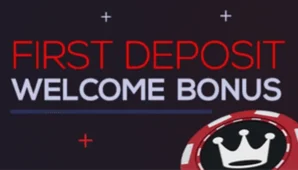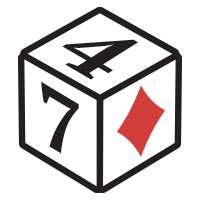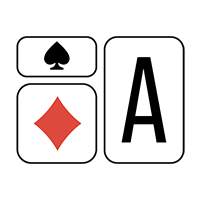DavyJones922 (Roberto Pérez) gave a rare and lengthy interview to the Spanish-speaking poker world recently. For those who don't want to watch YouTube's subtitles struggle to keep up, we translated the talk's highlights, but couldn't fit in an important part: the hand analysis that ended the interview.
Follow along as DavyJones goes deep into his though process in a couple of interesting hands. If you speak Spanish, watch the full interview here.
— It's a , a 3-bet SB pot against cutoff. The doubt I had is around the reasons for playing in one way or another. In this specific spot, c-bet range, because we got a number of interesting folds, even from pocket pairs like or backdoor straight draws. Do we prefer to leave his light calls with backdoor flush draws and check more when we block his flush draws? Do we check more with , or do we prefer to check to gain that EV from float-bets?
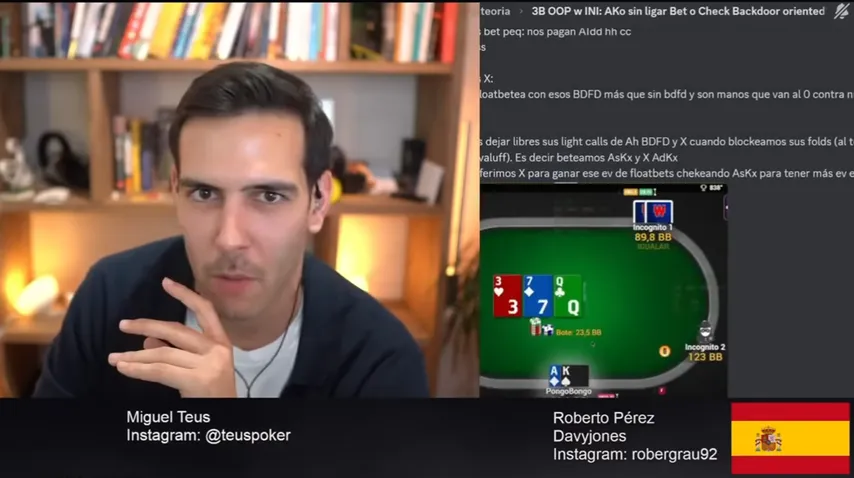
— This is why I say that I don't like filtering, because you are asking me this and I am thinking about something else, totally different. I have heard the approach, but to focus a little on how I would see it: the flop is generally the street in which I least tend to get out of line. In this case, a would make a range bet of 40%. I think it's range, really. High impact of the , backdoors, overcards, you have a depolarized range that will hit a lot on the turn when a draw opens.
You can bet 40% instead of a third, as it’s a rainbow board you will find fewer awkward turns, fewer combos to be completed, etc. What I'm getting at is that, on the flop, I have a kind of rule: it's the street where everything is worth more. If you look at c-bet situations in frequency, maybe there are very specific hands that benefit from c-bet, but then it always tends to be a kind of mix. From here, from there, have a little coverage everywhere.
Put hands that work well when betting and check turn to bluff-catch river, put hands that meet all the possible scenarios that can happen on turn and river. On the flop is when you can mix everything up a bit, and in this case I would c-bet range.
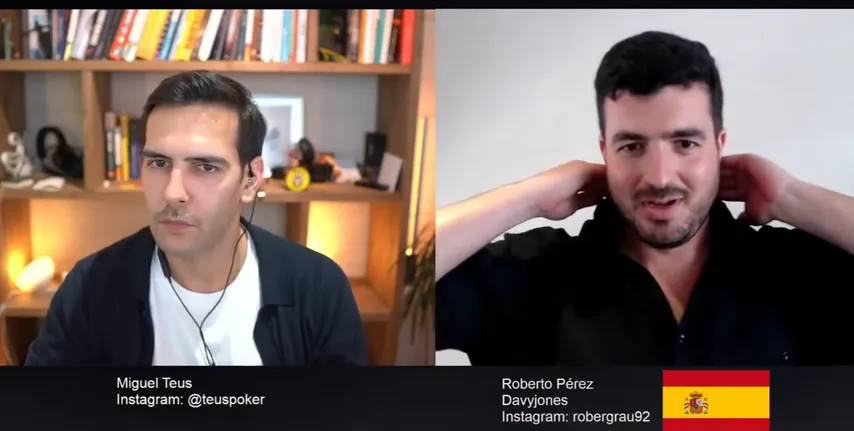
What I'm getting at is that you are deciding to step out of line, when you really don't know who the other person is, what their theoretical bases are. You are looking for a fold of and you don't know if the other is going to fold . So, for your hand to make sense, along with all that complex logic that you explained, which you have surely prepared, maybe the other one is not going to fold and your logic is over. What I'm trying to say is: you don't go so far out of theory looking for an exploit that you don't know if the other person is going to do. In no poker scenario, but less so on the flop, where everything is worth more and your range will benefit from making a c-bet range. That would be my logic a bit.
In relation to these exploits, I am also one of the defenders of the fact that behind the screen and behind the hand there is also a guy who takes notes from you. That is, imagine that you are on the exploitative line and you say: “I think he goes too far here, for this, for this and for this.” You call him and you get it right. Okay. But the other has also seen that you called him with a hand that shouldn’t be there, so be careful.
Be careful with exploits and with taking exploits from the flop. I will give the most extreme example: if sometimes I give you 5 or 10 seconds, which is what you have for thinking about a hand, maybe you don't even know what you’re betting or you don't even know what you call with. How could I know! If you don't even know an exact conclusion about whether I'm doing 85% of the range or 40%, what does the person in front of you know?
Be careful about drawing the line on exploits, where you abandon the theory and the EV of x strategy to make an exploit. How often does he bet ? You are not sure that he will bet into you with . Is he tricky or not tricky? Is he able to check a set or not? You are going out of line, in a line that requires many more parameters and much more knowledge of the game, that sometimes you don't even know about yourself enough for the person in front of you to know.
That's my reasoning in these types of situations. I wouldn't go so far outside the c-bet flop line, I would follow a theoretical line. If it’s a person with whom you play daily, you have many notes and you can branch out in this way, we would be talking about something else.
— Okay, noted. But in a solver you won't get a 100% c-bet with offsuit combos either, right?
— It never goes 100% c-bet, I think you'll get something like range 40%, maybe. Many times the c-bet frequency changes a little depending on the close hands that call. That is, if you play in a looser environment, in which offsuit is going to call you frequently in that spot, maybe it will c-bet more. Or if suited calls the 3-bet. If suddenly offsuit is a pure 4-bet/fold, and – folds you in frequencies, and suited is a fold, surely it has more check frequency. The line is drawn a bit between where the call is the closest, or the part that suffers the most with auto-folds, when deciding these mixed frequencies.
— Okay. One last thing with this hand: if you were forced to check or bet one of the two offsuit, which one would you bet more, with or without the , that is, with or without the dead suit?
— If I'm out of position, I would always rely on the backdoor to c-bet. If the board is rainbow, you would always have more incentive with the three aces with the suits on the table. And to pose the check-fold, or in this case the check-raise, it can work without the suit, because you leave more freedom for him to bet with some kind of backdoor. Imagine that maybe you are going to play check-fold with or kind of hands and consequently you are going to bet-miss some kind of low backdoor , some , , or suited, something like that. Those won't be very paid at 3-bet, but the same. I could bet-miss you by not touching your check-fold, and maybe there you could do it with the , which is a hand that has good properties in terms of top pair blockers. I would never do that with .
In the end I would give a lot of priority to the blockers of the top pairs, which will be the hand that will always be paying the 3-bet: offsuit and then offsuit, because I assume it will have some frequency there. Then perhaps I would leave, within the offsuit, with the suits on the board more c-bet and without the suit on the board you could propose some type of check-raise.
In relation to that hand, I am always a defender of spending time looking at a screen, spending time looking at a solver looking for logic and never considering that it’s wasted time. If you have spent an hour searching for the logic of why he used that suit and not the other, it will never be wasted time. It's time you've spent thinking. It's all poker and I'm sure it will have some contribution in the future. But you also need to know for whom those questions are: those questions are for Linus. The suits – that question is not your question right now. I'm talking about you or anyone who is more or less at those stakes.
First you have to have a solid game structure and have a defined playing style. And then we will begin to branch out and look for complex variables. But it's not good to ask the question of the most complex variables in the world when you don't even have a defined game structure. That is to say, it’s a mistake for you to go to the suit of the suit if you don’t know if that spot is 100% c-bet. That’s the logic I would follow: first a more basic logic and then a more complex logic.
— Okay, perfect.
- Increased first deposit bonus
- Increased rakeback and reloads
- Help with deposits and cashouts
- Access to private freerolls
- Round-the-clock support
— The last one is about a tournament where they made you smile, against Legenden, who came second. In terms of ICM, have you spent time on it? Are you going a little with flow?
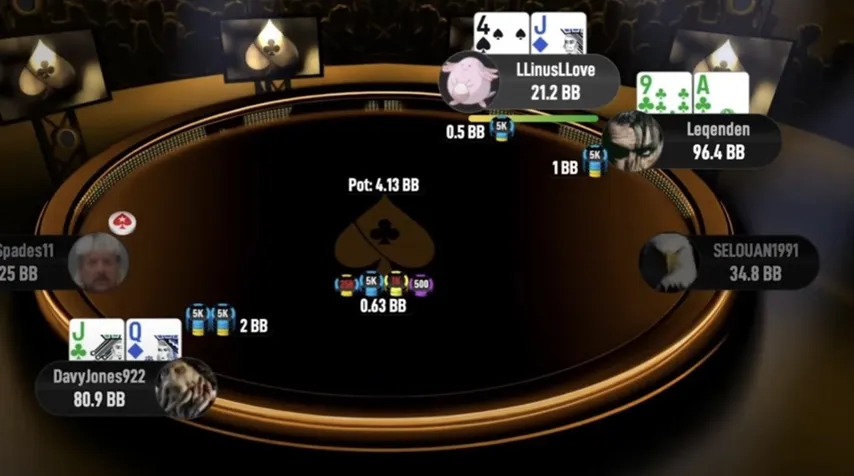
— Not enough. I hope no tournament player beats me up too much for anything I say here. I guess my idea here is that I am conditioned, but not that conditioned. I'm going to have to filter out many defending situations against him, perhaps calling a c-bet out of position, but I'm in a stack zone where I can still afford some luxury. It’s not the same to have 40bb here, where you are much more limited and there is much less margin, because losing any pot reverses my situation in the tournament more than it does now. Here I can make a defense with a hand that is close, or an OR and call the 3-bet with a hand that is close, because if I lose 20bb my scenario in the tournament doesn't change that much. I suppose that would be the first interesting point regarding my approach when it comes to VPIPing one hand or another.
This is a standard open raise and defend, it doesn't have much history either. I guess he's going to defend me quite loosely and he's going to hit me with quite a few polarized 3-bets. But hey, he also has to be careful. He doesn't have such an advantage over me that he can now 3-bet me on the face, if I win the spot I become first and second, and that conditions his defense.
When I analyze hands, I always like to go from back to front and I can't skip preflop. For me everything is linked in poker hands, it’s like some kind of art that is linked from the preflop to the river. Everything has a connection.
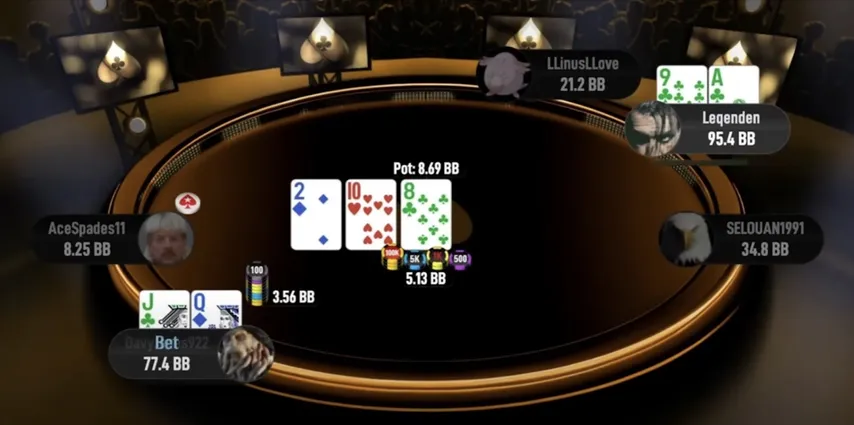
Same here, this is a flop that on average c-bets almost range on half pot. The portion of the Broadways you are opening from cutoff, which is usually a range of about 30-35%, closer to 30%, impacts a lot. Everything that is the Broadway of the 10x row, and then everything is overcards, everything is backdoors, so I would c-bet a lot.
I suppose that here, analyzing the context that I told you before, I would filter the c-bet a little more and would not be doing range. I would be playing a little more polarized style of play, I would try to have a little more equity, I would try not to make such big pots and take more hands to the showdown. Still, I have a gutshot to nuts touching the two backdoors, maybe I would check more with a . And the other remaining combos would be betting quite a bit. I would check a lot of , , backdoor suited hands. But hey, this one had potential.
— With a large size I imagine that he will defend more by calling than by raising.
— Yes, but he should still have raises. In this case, I am playing a little more polarized than at a table without ICM or a cash table. But even if you’re playing against polarized c-bets, you must always have a check-raise range that denies equity. Especially with the high volume of high cards here or my semi-depolarized c-bet, which is not strictly polarized. For example an , a suited, here would be a semi-depolarized c-bet, which can bluff-catch on the river in static runouts.
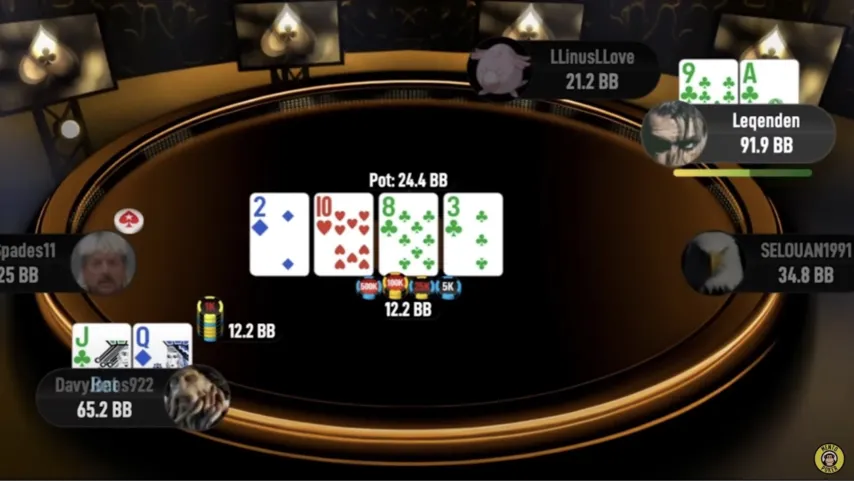
Well, in a cash hand with 100bb effective I would play from my sizing to overbet 1.5 pots, all the same size. I’d control the frequency of checking with hands that have very residual equity, that do not have a club. Those semi-thin-values would all go to the check. Whatever is an / , an / that semi-valuffed on the flop. Here, relying on the club and two overcards, I'm almost forced.
I’d also say that I assume that, in his situation, he is going to want to play aggressive lines against me. I don't know, I'm saying this now that I'm doing a little more in-depth analysis, but I think that when someone knows that they can put pressure and can bluff, there may be a small slowplay deficit. If he knows that he is going to want to put bluffs and pressure on me, I don't think he will have too many suited when going check-call. He knows he's going to bluff, so he's going to balance almost all of his value in a check-raise line. What does that do? That in static turns of this profile, I am allowed to make a relatively light second barrel with my value part, and consequently I can put in some extra bluffs.
In this case it’s a fairly natural hand, so there is little to say. The correct sizing would be 1.5, but between the SPR being a little smaller and what I am saying that I have to try to look for not so big pots and more materialization, I think I have to lower the sizing a little. You could use a neutral 3/4 size. In this case I went for pot but it will be between 3/4 and pot, to generate an SPR of approximately 1.5 on the river. In this case, with the club, I would bet the whole suited range.
—The guy calls. I don't know if you want to comment on anything about your check-call.
—Standard up to here. In reality the is a very static card, it can improve some suited, some suited, some suited. But for example suited would be a hand that I would check-raise quite a bit on the flop, because it can free up more of my raise/c-bet/fold. More of the A4 profile, any A5o that I have there as blockers. I'm going to open more suited than suited or something like that. So the suited can be interesting to check-raise to the flop. I'm not saying that I'm going to do it, but how I would propose it, since it generates a lot of EV by skipping backdoor situations, catching a fairly clean out and unlocking a lot of raise/c-bet/fold.
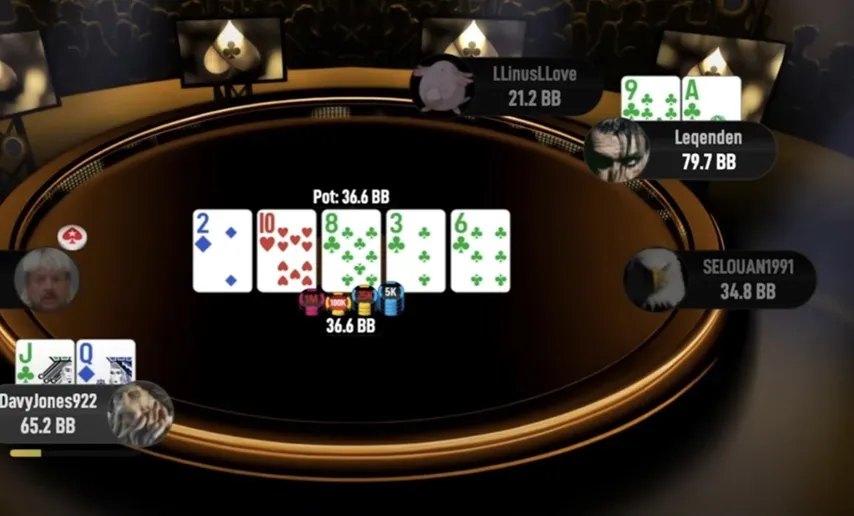
Well, the river comes, he checks and you have a decision. I think doesn't play much, to say the least, because I don't think it would have opened suited in this spot. With 8bb on the button and Linus with 20bb, I think I would have left the situation there letting the other 3 behind me kill themselves. So is irrelevant.
Now two concepts come into play here: keep in mind that most bluffs in poker – this is a theoretical concept – are often EV 0. Except for certain bluffs that have very good blocking properties. What does that mean? That most bluffing is going to be done out of balance, not because they print systematically. Imagine here a offsuit that just touches a lot of things, you print doing that bluff but generally you need more dynamic runouts. If you get a here, all bluffs are automatically EV 0. All of them.
Based on that concept, most of my bluffs are going to be in the zero zone. I'm now in a situation with a lot of ICM, where he has all the of the suit, the of the suit, plus some doubles of , or something like that. And everything that I have said that did not condition me preflop when it came to opening hands, defending or calling 3-bets, now it does condition me. Now there is 36bb in the middle and if I put 25bb here and he calls me it’s a disaster. That's not going to stop me from bluffing, but my bluff selection needs to be a bit better.
I also have to control even my thin-value. Maybe here an with the ace of the suit or the of the suit. For example, with the on the suit, where you touch a lot of flushes, it could be a fairly trivial bet. Or any overpair without the suit would be a neutral bet, fairly trivial. I don't know if I'm missing something there. But in this ICM situation, compromising my stack and future situations, I think I have to nit on my more close value and nit on my bluffs with worse properties.
— I think the best ones would be with the ace of clubs and the king of clubs, I understand?
— Definitely. / with the ace of the suit, or / that I have invented here with the ace of the suit.
— Thank you very much, the truth is that I admire you a lot, professionally and personally. Every time I have treated you, you were one of those people that you know are good people and for me that is the most important thing in life, to be a good person.
Dear Robert, I'll let you finish, I hope you have a very happy year personally and professionally.
— I hope that this conversation is of value to people, that they gain value from it. And that, above all, that they enjoy poker, that they enjoy everyday life, that in the end it's all about that. There are objectives and it’s about meeting those personal and professional goals, but in the end life is the path, it’s what we are doing now and we have to know how to enjoy it, value it and be grateful for it. It's key.
— Fantastic. See you guys in the next conversation, that will be in 20 years, when Robert has bought a soccer team in Mexico. Bye. Happy new year.
— Happy new year, bye Miguel.

